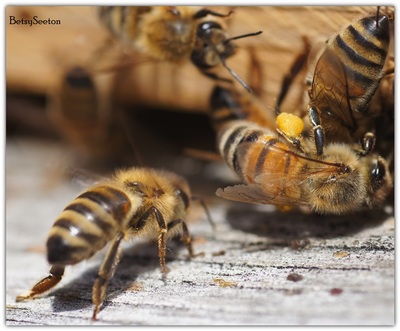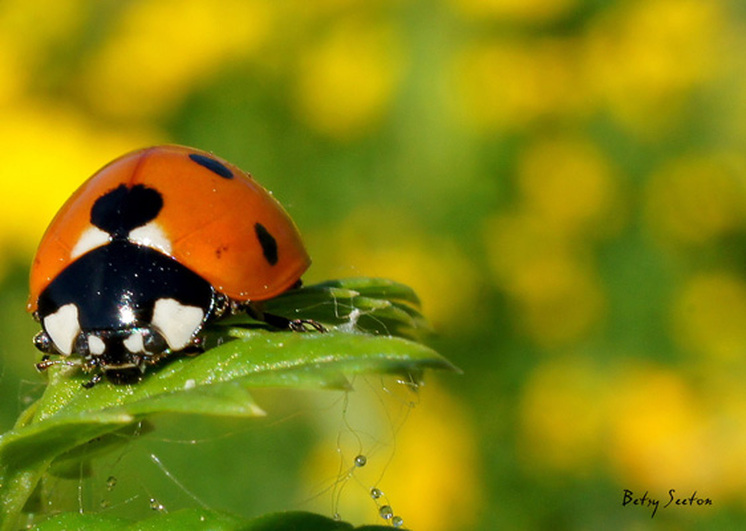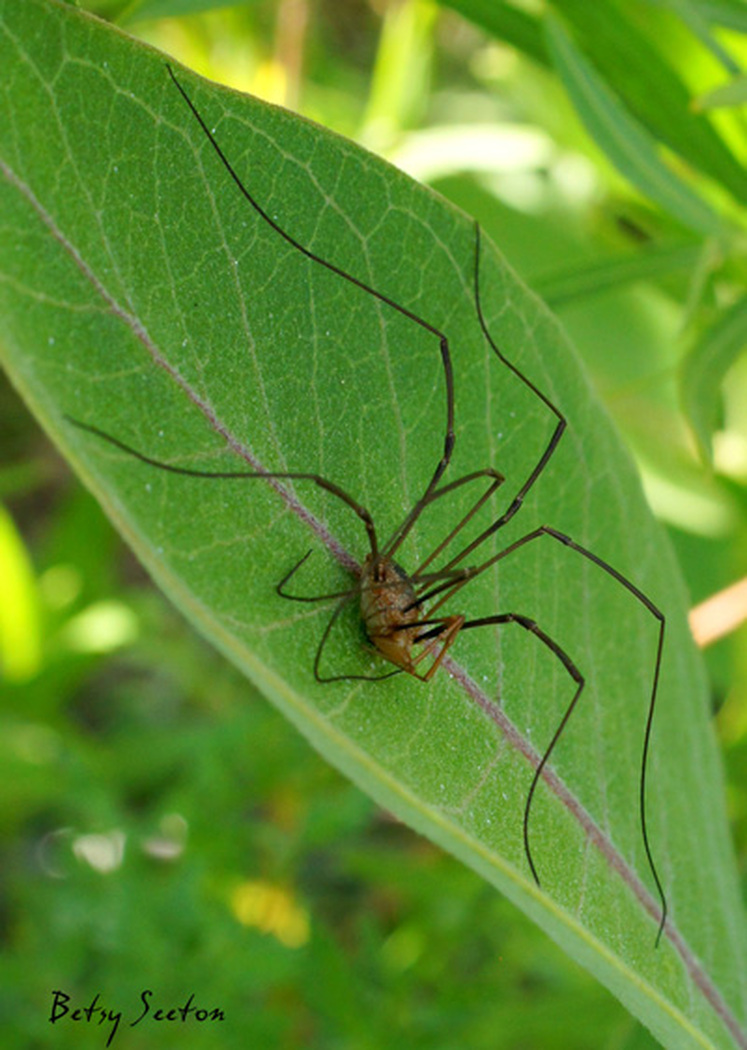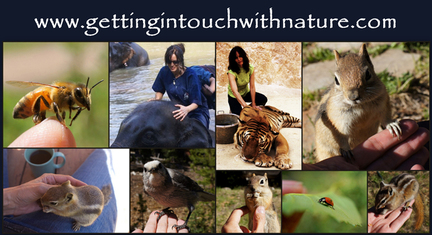|
I go out nearly every day in search of capturing insects through a camera lens. I commonly find grasshoppers, ladybugs and daddy longleg spiders. I've also become very familiar with damselflies, and of course, my honey bees. I can be found chasing down any flying creature! I go toward bumble bees and wasps, and even spiders. This yellow bug (above) was so calm and fearless. I love that. I see dragonflies every now and then. They are spectacular! I've seen ornate ones, huge ones and colorful ones. Each time I luck upon them, it's magical. I've only gotten distant shots so far. I can't wait to get a good capture! They take my breath away; so do butterflies. I've tried getting photos of various wasps, but they very rarely land on anything, so they're mostly in constant motion.  Blurry photo of damselflies mating Today I saw a pair of damselflies mating. They flew together in unison. I followed them for twenty yards or so, from one weed or blade of grass to the next, but then I got distracted for a nano second and lost sight of them. I got one semi blurry photo. What I love about my new interest in photographing insects, is the interaction with these little creatures. I'm finding ways to communicate with them and that's something I never thought was possible. I also love watching these creatures explore the world. Look at how this little guy (below) is reaching out to touch the plant. He had been on the green leaf and I introduced him to a flowering plant. He was moving all over it. Maybe it was a plant he wouldn't have normally been crawling around had I not placed him there. When I mention to people that I'm enjoying my macro lens and how interesting I find the insect world, I get a lot of blank stares and those nods that people give when they're thinking how weird someone is. Maybe it is weird. But it's an amazing world out there. There's so much life crawling around, flying around, hopping around, digging, hiding, eating, exploring, and capturing a tiny fraction of it through a lens is fascinating. Yesterday I followed a grasshopper around from blade of grass to blade of grass. They'll stay put if they don't fear me, but I have to get so close with my lens that I can see them seeing me and often they'll slide around the blade of grass so I can't see their eyes. They move from side to side like a game of hide and seek. But every once in a while, they get used to me, and realize I'm not going to hurt them. Yesterday that allowed me to pick up the little guy and let him walk around my hand. He stayed for quite sometime. As with all living creatures, I talked to him (or her.) I've read about grasshoppers spitting a tobacco like substance that other insects don't like. I've never had one do it to me. This little fella seemed quite happy to explore my hand and wasn't in a hurry to hop away. I do the same thing with ladybugs. I pick them up or pick up the leaf they're visiting sometimes. They will also hide from me, but they are less ready to fly off the way the grasshoppers are ever ready to hop away. I've gotten to where I know when a ladybug is going to fly off. I can see her outer shell begin to slowly open. Sometimes I can get the fear to subside and she'll stick around. Grasshopper Anatomy
Song of the grasshopper .... "That familiar chirping in the fields of the countryside is the result of grasshopper stridulation. A row of evenly spaced, minute pegs on the largest joint of the hindlegs is rubbed over the more prominent veins or ribs of the forewing. Usually, but not always, only the males can sing. Each species has its own song." source:http://www.planet-pets.com I loved how calm this daddy longleg spider was. I actually adjusted his legs for a better photo op (below) using a leaf to pull them straight. The spider let me move her legs without getting alarmed or trying to run! I thought that was pretty amazing! "Grasshoppers only weigh about 2 to 3 grams, but can thrust their legs against the ground at a force of 30 grams with legs half-extended. This works when leg muscles contract. This must all take place quickly, the thrust and contractions, because if the thrust builds up too slowly, the grasshopper will not get a quick take-off and the leap will not be very far. The northern grasshopper can actually leap 20 times the length of its body at full force." source: eHow.com by Emilia Lamberto. I think this might be some kind of moth (below), but I don't know. The texture looks like suede! I think this is a Mexican Bean Beetle. Here's what I learned today:
The Mexican bean beetle, formerly called the bean ladybird, is one of the most destructive insect pests of beans in New York State. The beetle feeds on the leaves of almost all types of beans, including snap, lima, pinto, navy, kidney, and soybeans. With snap beans, bush varieties seem to be attacked more readily than pole varieties. Most of the damage from the Mexican bean beetle occurs during July and August. Both the adult and the larval stages feed on the foliage, chewing out holes in the leaves. They usually feed on the undersides of the leaves, and sometimes will attack young pods and stems. As a result of feeding, only the veins are left, giving the leaves a lacy appearance. Yield may be greatly reduced and the entire planting may be destroyed in severe infestations. source: http://www.entomology.cornell.edu
2 Comments
Nona
7/28/2017 20:03:18
Humans are so selfish. They take everything the Earth produces, their own and everyone else's.
Reply
Betsy
7/28/2017 20:22:08
Hi Nona. Thank you for your insightful comment. I wish more people had your understanding and compassion. Thank you so much for sharing your thoughts.
Reply
Your comment will be posted after it is approved.
Leave a Reply. |
SEARCH LIVEHONESTLY
Loading
My LADYBUG photo book is now available for sale! This makes a stunning gift book or the perfect coffee table book that adds color and beauty to any setting. Full of inspiring quotes.
One square mile of land contains more insects than the total number of human beings on earth!
The Earth has a surface area of 196,939,900 square miles. It's estimated that there are more than 200 million insects for each human on the planet!
A recent New York Times article claimed that the world holds 300 pounds of insects for every pound of humans.
There are some 900 thousand different kinds of living insects known in the world. The true number of insect species can only be estimated from present and past studies. Anywhere from 1 million to 10 million insects may still be unidentified as yet, according to scientists.
Archives
September 2011
Categories
All
About insects ...
"These small, six-legged creatures include bees, ants, flies, mosquitoes, grasshoppers, crickets, butterflies, cockroaches, termites, fleas, and beetles. Although some insects annoy us by spreading disease, damaging crops and household items, and biting people and pets, these represent only about 17% of all the 800,000 species. The rest of the insects serve a very valuable purpose in nature. These serve as food for birds, frogs, fish, and other animals; pollinate crops; destroy other harmful insects; give us honey, bees wax, shellac, and silk; and keep the land clean by feeding on dead animals and plants." Source of the above: http://www.bigsiteofamazingfacts.com |





























 RSS Feed
RSS Feed
